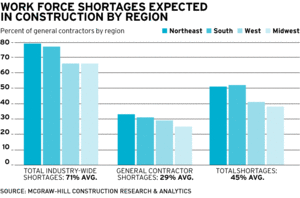

For many firms, future work force strategies may not be top-of-mind. After all, construction unemployment in May dragged along at 14.2%—almost double the national average—according to the U.S. Bureau of Labor Statistics. However, a recent survey on work force issues shows that more than 70% of general contractors expect work force shortages in design and construction by 2014. Nearly half (45%) expect shortages in the trades, with the top three being carpentry/millwork, electrical and concrete finishers/cement masons.
A firm's location and number of employees influence its executives' worries, says the study, conducted by McGraw-Hill Construction, which owns ENR. The largest percentage of executives concerned about work force shortages are based in the Northeast and the South, and more than 60% from the South think the shortage for general contractors will be serious. While the percentage of executives from small and large firms who expect shortages is consistent, 33% of respondents from firms of 500 or more employees are strongly convinced that a general contractor shortage is looming.
So what is driving these concerns, and what size firms see the greatest impact? The biggest concern is the loss of knowledge and company experience due to leaders retiring. As with most industries, baby boomers dominate leadership of construction firms, and many of them are poised for retirement. The second largest concern addresses downsizing during the recession and varies by size of firm. For firms with less than 50 employees, executives believe loss of company knowledge and experience due to layoffs will not be easy to replace. In some cases, individuals who were laid off found jobs in different careers to survive, and the concern is that they may not want to return to construction out of fear the situation will repeat itself. For firms with more than 50 employees, construction's lack of appeal for the younger generation ranks higher than the loss of experience and skills.
This study reveals a few important work force strategies. Firms can promote opportunities and technological changes that will make working in construction more appealing to younger employees. To fill short-term gaps, firms can also engage those who have left to help mentor future leaders. Currently, 45% of contracting firms say they have already adopted mentoring programs. Certification is also critical, with 66% saying that certifying employees increases competitiveness and the ability to win contracts, and the bigger the firm, the more important that benefit is, with 77% of executives from the largest firms embracing it.
Two areas changing the industry and attracting new workers are green construction and technology, such as building information modeling. Firms of 500 employees or more are developing staff expertise through in-house training. Smaller firms say they need to do the same. Construction executives must consider how they will address new work force skills and the expertise to meet future demands, the study says.
The report is available online at www.construction.com/market_research.

Post a comment to this article
Report Abusive Comment